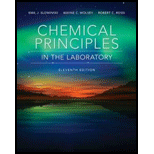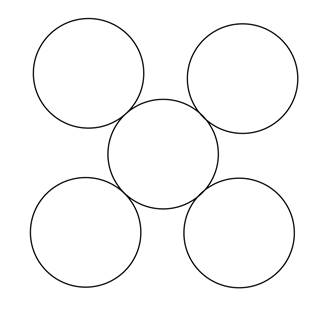
Concept explainers
In an FCC structure, the atoms are found on the corners of the cubic unit cell and at the center of each face. The unit cell has an edge whose length is the distance from the center of one corner atom to the center of another corner atom on the same edge. The atoms on the diagonal of any face are touching. One of the faces of the unit cell is shown below in the following:

a. Show the distance
b. What is the relationship between the length of the face diagonal and the radius of the atoms in the cell?
Face diagonal
c. How is the radius of the atoms related to
d. Silver metal crystals have an FCC structure. The unit cell edge in silver is
______________
Trending nowThis is a popular solution!

Chapter 16 Solutions
Chemical Principles in the Laboratory
- 2. Identify the strongest type of intermolecular force that exists between each pair of compounds: a. Ammonium chloride / H₂O b. OH C. d.arrow_forwardREPORT FOR EXPERIMENT 9 (continued) NAME F. Solubility vs. Temperature; Saturated and Unsaturated Solutions Data Table: Circle the choices which best describe your observations. NaCl 1.0 g +5 mL water 1.0 g +5 mL water +1.4 g dissolved completely? yes/no saturated or unsaturated? dissolved completely? yes/no saturated or unsaturated? 2.4 g +5 mL water +heat dissolved completely? yes/no saturated or unsaturated? 2.4 g +5 mL water after cooling dissolved completely? yes/no saturated or unsaturated? NHC dissolved completely? yes/no saturated or unsaturated? dissolved completely? yes/no saturated or unsaturated? dissolved completely? yes/no saturated or unsaturated? dissolved completely? yes/no saturated or unsaturated? G. Ionic Reactions in Solution 1. Write the word and formula equations representing the chemical reaction that occurred between the barium chloride solution, BaCl,(aq), and the sodium sulfate solution, Na SO (aq). Word Equation: Formula Equation: 2. (a) Which of the…arrow_forwardIn the drawing areas below, draw the two most expected stable conformations of the following molecule: ייון Be sure your drawings make it possible to distinguish between the conformations. After you've drawn the conformations, answer the question below the drawing areas. Х S : ☐ ☑ 5arrow_forward
- Add curved arrows to show the forming and breaking of bonds in the reaction below. :Br: H 2 Add/Remove step ☑ H-Br: G હે Parrow_forwardPlease correct answer and don't use hand ratingarrow_forwardSafari File Edit View History Bookmarks Window Help く < mylabmastering.pearson.com Wed Feb 12 8:44 PM ✩ + Apple Q Bing Google SignOutOptions M Question 36 - Lab HW BI... P Pearson MyLab and Mast... P Course Home Error | bartleby b Answered: If the biosynth... Draw a free-radical mechanism for the following reaction, forming the major monobromination product: ScreenPal - 2022 CHEM2... Access Pearson 2 CH3 Br-Br CH H3 Draw all missing reactants and/or products in the appropriate boxes by placing atoms on the canvas and connecting them with bonds. Add charges where needed. Electron- flow arrows should start on the electron(s) of an atom or a bond and should end on an atom, bond, or location where a new bond should be created. Include all free radicals by right-clicking on an atom on the canvas and then using the Atom properties to select the monovalent radical. ▸ View Available Hint(s) 0 2 DE [1] H EXP. CONT. H. Br-Br H FEB 12arrow_forwardPlease correct answer and don't use hand ratingarrow_forwardNonearrow_forwardQ1: For each molecule, assign each stereocenter as R or S. Circle the meso compounds. Label each compound as chiral or achiral. + CI Br : Н OH H wo་ཡིག་ཐrow HO 3 D ။။ဂ CI Br H, CI Br Br H₂N OMe R IN I I N S H Br ជ័យ CI CI D OHarrow_forwardarrow_back_iosSEE MORE QUESTIONSarrow_forward_ios
 Chemical Principles in the LaboratoryChemistryISBN:9781305264434Author:Emil Slowinski, Wayne C. Wolsey, Robert RossiPublisher:Brooks Cole
Chemical Principles in the LaboratoryChemistryISBN:9781305264434Author:Emil Slowinski, Wayne C. Wolsey, Robert RossiPublisher:Brooks Cole Chemistry: Principles and PracticeChemistryISBN:9780534420123Author:Daniel L. Reger, Scott R. Goode, David W. Ball, Edward MercerPublisher:Cengage Learning
Chemistry: Principles and PracticeChemistryISBN:9780534420123Author:Daniel L. Reger, Scott R. Goode, David W. Ball, Edward MercerPublisher:Cengage Learning Chemistry & Chemical ReactivityChemistryISBN:9781337399074Author:John C. Kotz, Paul M. Treichel, John Townsend, David TreichelPublisher:Cengage Learning
Chemistry & Chemical ReactivityChemistryISBN:9781337399074Author:John C. Kotz, Paul M. Treichel, John Townsend, David TreichelPublisher:Cengage Learning Chemistry & Chemical ReactivityChemistryISBN:9781133949640Author:John C. Kotz, Paul M. Treichel, John Townsend, David TreichelPublisher:Cengage Learning
Chemistry & Chemical ReactivityChemistryISBN:9781133949640Author:John C. Kotz, Paul M. Treichel, John Townsend, David TreichelPublisher:Cengage Learning Chemistry: The Molecular ScienceChemistryISBN:9781285199047Author:John W. Moore, Conrad L. StanitskiPublisher:Cengage Learning
Chemistry: The Molecular ScienceChemistryISBN:9781285199047Author:John W. Moore, Conrad L. StanitskiPublisher:Cengage Learning General Chemistry - Standalone book (MindTap Cour...ChemistryISBN:9781305580343Author:Steven D. Gammon, Ebbing, Darrell Ebbing, Steven D., Darrell; Gammon, Darrell Ebbing; Steven D. Gammon, Darrell D.; Gammon, Ebbing; Steven D. Gammon; DarrellPublisher:Cengage Learning
General Chemistry - Standalone book (MindTap Cour...ChemistryISBN:9781305580343Author:Steven D. Gammon, Ebbing, Darrell Ebbing, Steven D., Darrell; Gammon, Darrell Ebbing; Steven D. Gammon, Darrell D.; Gammon, Ebbing; Steven D. Gammon; DarrellPublisher:Cengage Learning





